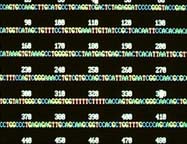Genome exposes buried bugs

Human DNA analysis catches disease-causing culprits. <br>© SPL <br>
Knowing the human genetic sequence helps unearth invaders.
Human DNA is a new device for disease detectives. The database of human genetics can expose misfit microbe genes in diseased tissues, a US team have found.
Matthew Meyerson, of the Dana-Farber Cancer Institute in Boston, and his colleagues compared 7,000 DNA sequences extracted from cervical cancer cells to the vast database of human genes – and pulled out two misfits. Both were from a virus known to cause the cancer1.
“I was delighted,” says Meyerson apropos his find. He hopes to identify infectious bugs or viruses that are implicated in disease using the technique.
“It’s promising,” agrees pathologist Patrick Moore of Columbia University in New York. Infection is thought to trigger the onset of some cancers, as well as autoimmune diseases such as diabetes, but the identity of the bacteria or viruses at work remain unknown. A new method “is critically needed”, claims Meyerson.
Tracking down a microbe’s few incriminating genes amongst the many thousand human ones “is a hell of a hard thing to do”, says Moore. He likens it to searching through two versions of the Oxford English Dictionary for a single missing word.
Researchers pull off the feat by creating libraries of active genes from healthy and diseased human tissues; the latter incorporate those of resident pathogens. Previously, researchers compared the two by hand – a time-consuming process.
The findings may prompt many to turn to computers for their screening studies, predicts Moore. High-throughput techniques can now quickly determine the DNA make-up of genes in a library; comparing them to sequences in the human-genome database takes only an hour on a desktop computer. Meyerson’s group plans to create and sequence libraries from many diseased tissues.
But some microbes may be hard to pin down, warns Moore. Many bacteria and viruses naturally inhabit the body and it may be difficult to sift these from those that cause disease.
References
- Weber, G. et al. Identification of foreign gene sequences by transcript filtering against the human genome. Nature Genetics, DOI 10.1038/hg818, (2002).
Media Contact
All latest news from the category: Health and Medicine
This subject area encompasses research and studies in the field of human medicine.
Among the wide-ranging list of topics covered here are anesthesiology, anatomy, surgery, human genetics, hygiene and environmental medicine, internal medicine, neurology, pharmacology, physiology, urology and dental medicine.
Newest articles

Detector for continuously monitoring toxic gases
The material could be made as a thin coating to analyze air quality in industrial or home settings over time. Most systems used to detect toxic gases in industrial or…

On the way for an active agent against hepatitis E
In order to infect an organ, viruses need the help of the host cells. “An effective approach is therefore to identify targets in the host that can be manipulated by…

A second chance for new antibiotic agent
Significant attempts 20 years ago… The study focused on the protein peptide deformylase (PDF). Involved in protein maturation processes in cells, PDF is essential for the survival of bacteria. However,…





















